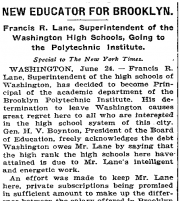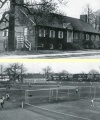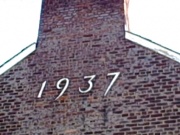Prologue: Sounder Bodies and Surer MoralsFrom The Peopling of New York CityGo back: Friends Forever
 Francis Lane is the new principal of Polytech. Photo credit: New York Times.[1]  A view of Washington Cemetery from what was then the Culver Line Elevated. Photo Credit: David Shankbone on Wikipedia. [2] Setting: 1905 in Brooklyn, NY. It is a time of great expansion for Brooklyn. Between 1838 and 1899, Green-wood Cemetery is created[3], the Brooklyn Academy of Music is initiated[4], and Prospect Park goes public.[5]
In 1899, the Brooklyn Children's Museum, the world's first children's museum, opens, and in 1903, the Williamsburg Bridge, the largest suspension bridge of its time, is completed. A year later the first NYC subways begins operating.[6][7]
As Brooklyn experienced a cultural boom with the growth of parks, museums, and advanced transportation, Polytechnic Preparatory Institute, a small school located in Brooklyn, was settling the purchase a plot of land for use as an athletic field. The field, in the heart of Midwood, is adjacent to Washington Cemetery at Avenue L and East Fourth Street. It was called the Village Oval, named after the Village Base Ball Club. [8]
Francis Lane, the headmaster at the time, finalized the purchase. He extolled it as an asset that will "ensure sounder bodies and surer morals…more consistent scholarship and a finer esprit de corps…."[9] Every day after school, countless students would ride to the grounds, now called Poly Fields[10], on the Culver Line Elevated (the F train). [11]
But in 1916, Polytech Prep bought a new field in Dyker Heights. Poly Fields fell out of use, described by its next set of owners (see below) as an “overgrown field.”[12]
Henry Chandlee Turner founded Turner Construction Company back in 1902. His next proposition, while not as famous, would impact the lives of thousands of children. Turner was parent at the Brooklyn Friends School, a Quaker school located in Brooklyn and run by the Quaker New York Monthly Meeting of the Religious Society of Friends.[13] The school wanted to purchase a lovely little field, 6.7 acres large, at the corner of East Fourth Street and Avenue L in Brooklyn. It was the field abandoned by Poly Tech. Turner decided to donate the initial down payment, with the hope that the children of the Brooklyn Friends School, as well as the children of the neighborhood, would come to the park and experience the pure joy of an open space of greenery.[14]
The field was spacious, with room for multiple games of sports like soccer, field hockey, and football. In 1924, the school built two tennis courts; in 1927, four more courts were constructed.[15]
 The Tomb of the Unknowns at Arlington National Cemetery, designed by architect Lorimer Rich. Photo credit: US Air Force[19] 1937, at the field. Lorimer Rich was another Brooklyn Friends parent, and he was equally famous for his work outside the school as an architect of the Tomb of the Unknowns, where he would eventually be buried.[20] He designed the new field house at the field. There were two field houses there when the school originally purchased the land. The children used it to change, shower, and store their belongings while they played outside. By 1935, the school realized the buildings were no longer sufficient, and they decided to rebuild with a two-story field house. By May of 1937, the Brooklyn Friends School had enough funds to begin the work; it was completed by Thanksgiving of the same year.[21]
Continue reading: References
|




